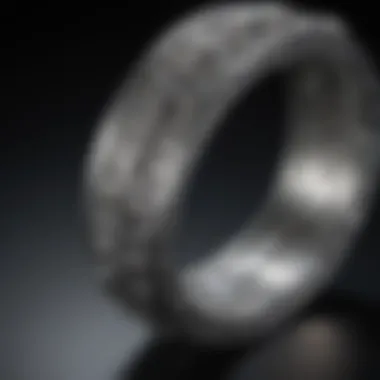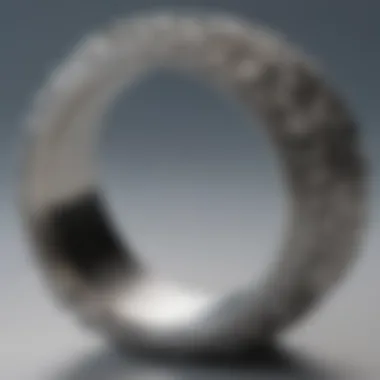Unveiling the Mastery of Sterling Silver Casting Molds: Craftsmanship Revealed


Rock and Fossil Identification
In the realm of sterling silver casting molds, akin to the identification of rocks and fossils, distinctive characteristics and intricate details set pieces apart. Understanding the various types of molds used, ranging from one-part to complex multipart molds, is analogous to discerning different rock formations. Just as in rock and fossil identification, where keen observation is key, identifying the nuances and intricacies of molds requires a trained eye. Tools such as silicone rubber for mold making and specialized carving tools for refining details play a vital role in precision, much like the tools utilized in rock and fossil identification that help unearth hidden features.
Craftsmanship in Mold Making
Delving into the process of creating sterling silver casting molds unveils a world of meticulous craftsmanship. From designing the initial model to forming the mold itself, each step mirrors the attention to detail required in crafting one-of-a-kind silver pieces. Exploring the intricacies of mold making evokes a sense of artistic expression akin to the detailed work involved in understanding the composition of rocks and fossils. Just as different rocks entail distinct identification methods, each mold demands careful consideration of details, ensuring an accurate representation in the final piece.
The Alchemy of Sterling Silver Casting
Embarking on the journey of sterling silver casting introduces a realm of alchemy, akin to the transformative processes witnessed in geological formations. The fusion of silver within the confines of a carefully crafted mold echo the metamorphic changes occurring deep within the Earth's crust. Just as geological formations offer insights into the Earth's history, the art of sterling silver casting reveals a narrative of transformation and creativity. By understanding the intricate interplay of heat and material, artisans can bring forth stunning silver pieces much like the unveiling of hidden gems within rocks.
Mastering the Art of Detailing
Elevating silver casting to an art form lies in the mastery of detailing. Intricate designs and delicate features akin to fine engravings on stones require precision and expertise. Just as geologists uncover hidden layers within rock strata, artisans delve into the depths of expression through meticulous detailing. The artistry involved in finishing touches mirrors the careful preservation methods used for rocks, underscoring the importance of precision and care in both realms. Through mastering the art of detailing, artisans bring forth timeless silver creations that captivate and inspire, much like the allure of rare geological finds.
Introduction to Sterling Silver Casting Molds
Understanding the Significance of Sterling Silver Casting
Historical Evolution of Silver Casting
The Historical Evolution of Silver Casting stands as a hallmark in the realm of metalworking, tracing back centuries of tradition and innovation. This aspect of silver casting holds a profound significance in the context of this article as it lays the foundation for understanding the heritage and time-honored techniques employed in the art of silver molding. The key characteristic that sets the Historical Evolution of Silver Casting apart lies in its ability to blend traditional craftsmanship with modern advancements, offering a unique blend of aesthetics and functionality. This historical journey not only adds depth to the overall narrative of sterling silver casting molds but also serves as an inspiration for artisans and enthusiasts alike seeking to pay homage to the roots of this exceptional art form.
Properties of Sterling Silver for Molding


Diving into the Properties of Sterling Silver for Molding reveals a wealth of advantages and considerations essential for creating impeccable silver pieces. This pivotal aspect contributes significantly to the overarching theme of the article by shedding light on the intrinsic qualities of sterling silver that make it an ideal choice for molding. The key characteristic of sterling silver lies in its malleability and durability, making it a preferred material for intricate designs and detailed molds. Despite its benefits, there are challenges to navigate, such as its tendency to tarnish and require meticulous care. Understanding these properties not only enhances the appreciation for sterling silver but also underscores the craftsmanship required to work with this precious metal.
Exploring the Process of Mold Making
Types of Casting Molds
Embarking on an exploration of the Types of Casting Molds opens up a world of possibilities in the realm of silver casting. Understanding the nuances of various mold types is essential for artisans and enthusiasts looking to master the art of sterling silver mold making. Whether it's investment casting, centrifugal casting, or sand casting, each type brings its own set of advantages and considerations to the table. The key characteristic of exploring diverse casting molds lies in the versatility it offers, allowing craftsmen to experiment with different techniques and approaches to achieve their desired artistic outcomes. By delving into the intricacies of each mold type, a deeper understanding of the molding process is gained, empowering individuals to harness the full potential of silver casting.
Materials and Tools Required
Unveiling the Materials and Tools Required for mold making unveils the essential components necessary for bringing silver casting molds to life. From refined casting powders to specialized sculpting tools, each material and tool plays a crucial role in shaping the final outcome of a silver piece. Understanding the key characteristic of these materials and tools underscores their significance in the mold making process, emphasizing precision and craftsmanship. Despite the advantages these materials and tools offer in creating intricate molds, there are challenges such as mastering their usage and ensuring consistency in mold production. By grasping the importance of selecting the right materials and tools, artisans can elevate their craft and produce sterling silver pieces that exemplify excellence.
Techniques for Sterling Silver Casting
Sterling silver casting demands a profound understanding of the intricacies within the casting process. The techniques employed are crucial components in ensuring the quality and precision of the final silver pieces. Mastering the techniques for sterling silver casting requires a blend of artistry, skill, and technical knowledge. Each step in the casting process, from mold preparation to final polishing, contributes to the overall outcome of the piece. By exploring the various techniques for sterling silver casting, artisans can fine-tune their craft and create bespoke silver creations that showcase their expertise and creativity.
Investment Casting in Sterling Silver
Wax Models and Patterns:
Investment casting in sterling silver begins with the creation of wax models and patterns. These intricate models serve as the foundation for the final silver piece, capturing every detail and design element with precision. The use of wax models allows artisans to experiment with different shapes and forms before committing to the casting process. One key benefit of wax models is their ability to capture intricate details that might be challenging to achieve through other casting methods. However, the fragility of wax can pose challenges during the casting process, requiring careful handling and expertise to prevent damage.
Investment Casting Process Steps:
The investment casting process involves several key steps essential to achieving a successful cast in sterling silver. From creating the mold to burning out the wax and pouring molten silver, each step requires precision and attention to detail. One significant advantage of the investment casting process is its ability to produce highly intricate and detailed silver pieces. The process allows artisans to replicate complex designs with accuracy, making it a popular choice for crafting intricate jewelry and decorative items. However, the investment casting process can be time-consuming and labor-intensive, requiring patience and skill to master.


Sand Casting Methods
Sand Mold Preparation:
Sand casting is a versatile method commonly used in sterling silver casting due to its simplicity and cost-effectiveness. Sand mold preparation involves creating a cavity in sand that matches the desired shape of the final silver piece. The key characteristic of sand mold preparation is its adaptability to various shapes and sizes, making it a popular choice for artisans seeking flexibility in their casting process. One unique feature of sand mold preparation is its ability to withstand high temperatures without deforming, ensuring the mold retains its shape during the casting process. While sand casting offers flexibility and cost-efficiency, it may not be suitable for highly intricate designs that require extreme precision.
Pouring Liquid Silver into the Mold:
Once the sand mold is prepared, the next step in sand casting involves pouring liquid silver into the mold. This process demands skill and precision to ensure the molten silver fills the mold completely, without trapping air bubbles or impurities. One key characteristic of pouring liquid silver into the mold is the rapid solidification of the metal, allowing for quick production of silver pieces. This method is beneficial for artisans looking to create multiple pieces in a time-efficient manner. However, the process requires careful monitoring of the silver temperature and pouring technique to achieve consistent results. Sand casting offers a balance between cost-effective production and the ability to create various silver designs, making it a popular choice among artisans seeking versatility in their casting methods.
Artistry and Design in Sterling Silver Molds
In this comprehensive guide on exploring the intricate craft of sterling silver casting molds, the significance of artistry and design plays a pivotal role in shaping the timeless elegance of silver pieces. Artistry and design in sterling silver molds not only reflect the creativity and skill of artisans but also elevate the overall aesthetic appeal of the final products, making them coveted possessions for collectors and enthusiasts alike. The attention to detail, precision in creating intricate designs, and the artistic vision imbibed in every piece demonstrate the craftsmanship and expertise required in sterling silver mold-making.
Intricate Designs and Patterns
Filigree Work
Filigree work stands out as a hallmark of excellence in sterling silver molds, characterized by delicate and intricate wire patterns meticulously incorporated into the design. The specific aspect of filigree work contributes to the overall beauty and aesthetic value of silver pieces, adding a sense of delicacy and sophistication. The key characteristic of filigree work lies in its intricacy and finesse, requiring highly skilled artisans to intricately weave silver wires to form intricate patterns or motifs, enhancing the overall appeal of the mold. The unique feature of filigree work lies in its ability to create airy and lightweight designs while maintaining structural integrity, offering a visually stunning and lightweight option for silver pieces.
Embossing and Engraving Techniques
Embossing and engraving techniques bring a touch of personalization and intricacy to sterling silver molds, contributing to the overall artistic expression of each piece. The key characteristic of embossing and engraving techniques lies in their ability to add depth and texture to the surface of silver pieces, creating visually captivating patterns or designs. These techniques are a popular choice for this article as they allow artisans to customize silver molds according to specific needs or preferences, enhancing the aesthetic appeal and uniqueness of each piece. The unique feature of embossing and engraving techniques is their versatility in creating intricate designs or personalized messages, adding a personalized touch to sterling silver pieces while highlighting the craftsmanship and attention to detail involved in the mold-making process.
Quality Control and Polishing Techniques


In the art of sterling silver casting molds, Quality Control and Polishing Techniques play a paramount role to ensure the excellence and precision of the final silver pieces. Quality control is vital in every step of the production process, from mold making to the casting stage. Inspecting the molds for any imperfections and ensuring the proper mix of materials are essential quality control measures. Polishing techniques, on the other hand, elevate the aesthetic appeal of the silver pieces, guaranteeing a flawless finish that captures the intricate details of the design.
Ensuring Precision in Casting
Casting Defects and Remedies:
Discussing Casting Defects and Remedies sheds light on potential challenges faced during the casting process. Identifying common defects such as porosity or incomplete fills in the cast silver allows artisans to rectify these issues efficiently. Remedies like adjusting the casting temperature or refining the mold can significantly improve the overall quality of the final piece. The meticulous attention to detail required in addressing casting defects highlights the dedication to achieving perfection in sterling silver molding.
Post-Casting Polishing Methods:
Post-casting polishing methods are indispensable for bringing out the true brilliance of sterling silver pieces. By employing techniques such as hand polishing or utilizing specialized machinery, artisans can refine the surface of the silver, removing any blemishes or imperfections. The key characteristic of post-casting polishing lies in its ability to enhance the luster and smoothness of the silver, elevating its visual appeal to a new level. While time-consuming, the advantages of post-casting polishing methods are evident in the unparalleled shine and finish they impart to each intricately crafted silver piece.
Conclusion: The Craftsmanship of Sterling Silver Molds
In this intricate world of sterling silver casting molds, the Conclusion section serves as a pivotal reflection on the exquisite artisanship and dedication required in creating timeless silver pieces. It encapsulates the essence of the entire article, highlighting the meticulous processes and the refined skills essential for crafting sterling silver molds. The significance of the craftsmen's expertise and attention to detail is underscored, emphasizing how each piece is a work of art meticulously brought to life through the merging of traditional techniques with modern innovations.
Noteworthy elements of the Conclusion include an in-depth exploration of the legacy passed down by silver casting artisans through generations. By delving into the rich history and evolution of silver mold craftsmanship, readers gain a profound appreciation for the artisanal heritage that shapes contemporary silver casting practices. The Conclusion section also sheds light on the enduring relevance of these traditional skills in a digital age, demonstrating how mastery of the craft continues to inspire and influence modern interpretations of silver mold design.
Legacy of Silver Casting Artisans
Modern Innovations in Silver Casting:
Within the realm of silver casting, modern innovations play a crucial role in pushing the boundaries of creativity and efficiency. One key aspect that distinguishes modern innovations in silver casting is the integration of digital technology into traditional mold-making processes. This fusion allows artisans to enhance precision and intricacy in their designs, enabling the realization of intricate patterns and complex structures that were once challenging to achieve manually.
The main characteristic that sets modern innovations apart is the ability to create customized molds rapidly and with unparalleled accuracy. This efficiency not only saves time but also expands the creative possibilities for artisans, empowering them to experiment with unconventional shapes and styles. Despite these advantages, some purists may argue that the craft's inherent charm and human touch are somewhat diminished by the mechanization involved in modern silver casting techniques.
Appreciating the Art of Sterling Silver Molds:
Appreciating the artistry of sterling silver molds involves understanding the fusion of creativity and technical skill required to produce exceptional pieces. One notable aspect worth highlighting is the emphasis on handcrafted details that infuse each mold with a unique character and charm. This personal touch adds depth and emotion to the finished silver pieces, resonating with collectors who value artisanal craftsmanship.
A key characteristic of appreciating the art of sterling silver molds lies in the ability to convey intricate designs and symbols that tell compelling stories. These narratives enrich the aesthetic appeal of the silver pieces, turning them into more than mere adornments but symbolic works of art. While the manual labor involved in handcrafting silver molds can be time-consuming, the unparalleled beauty and individuality of each piece justify the meticulous effort invested in preserving and advancing this timeless art form.







